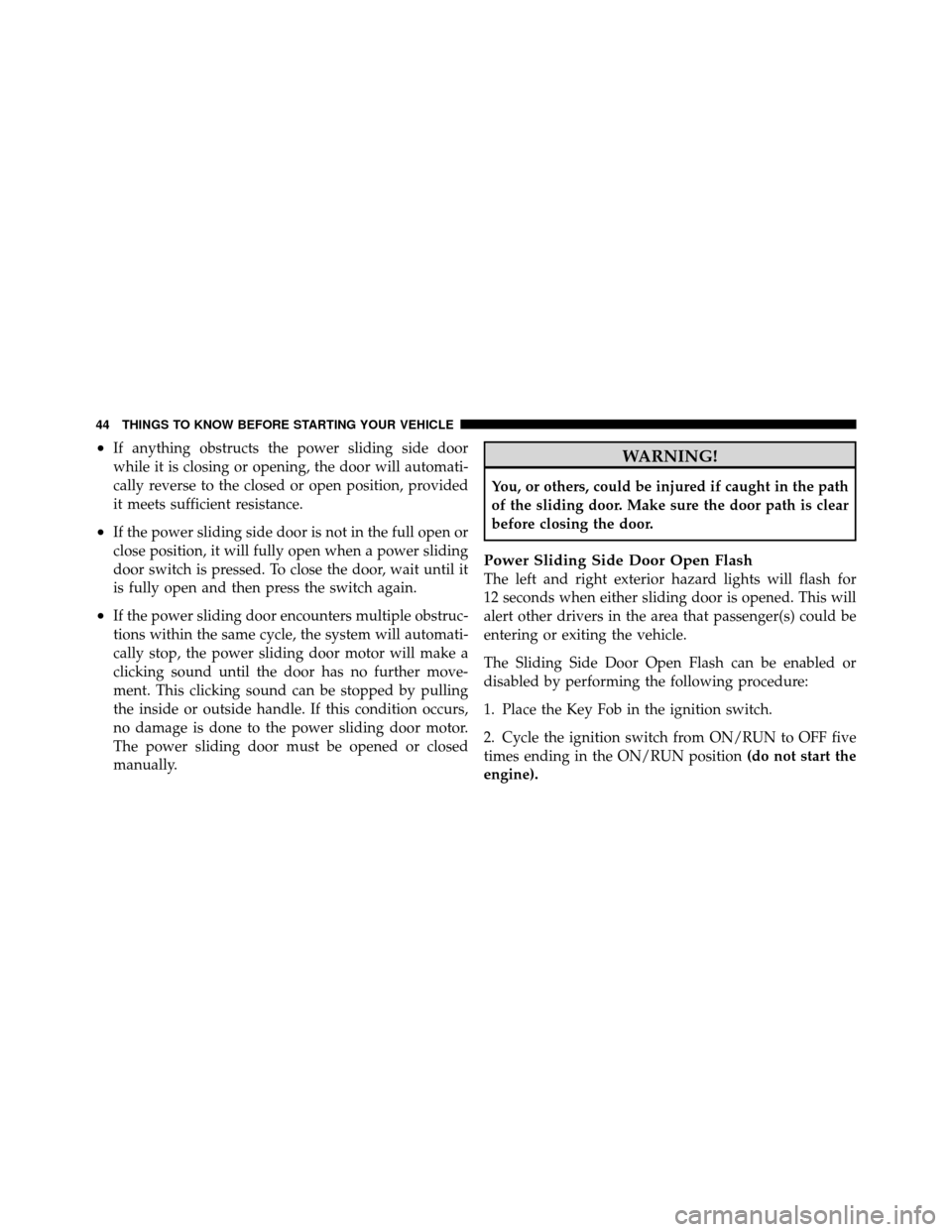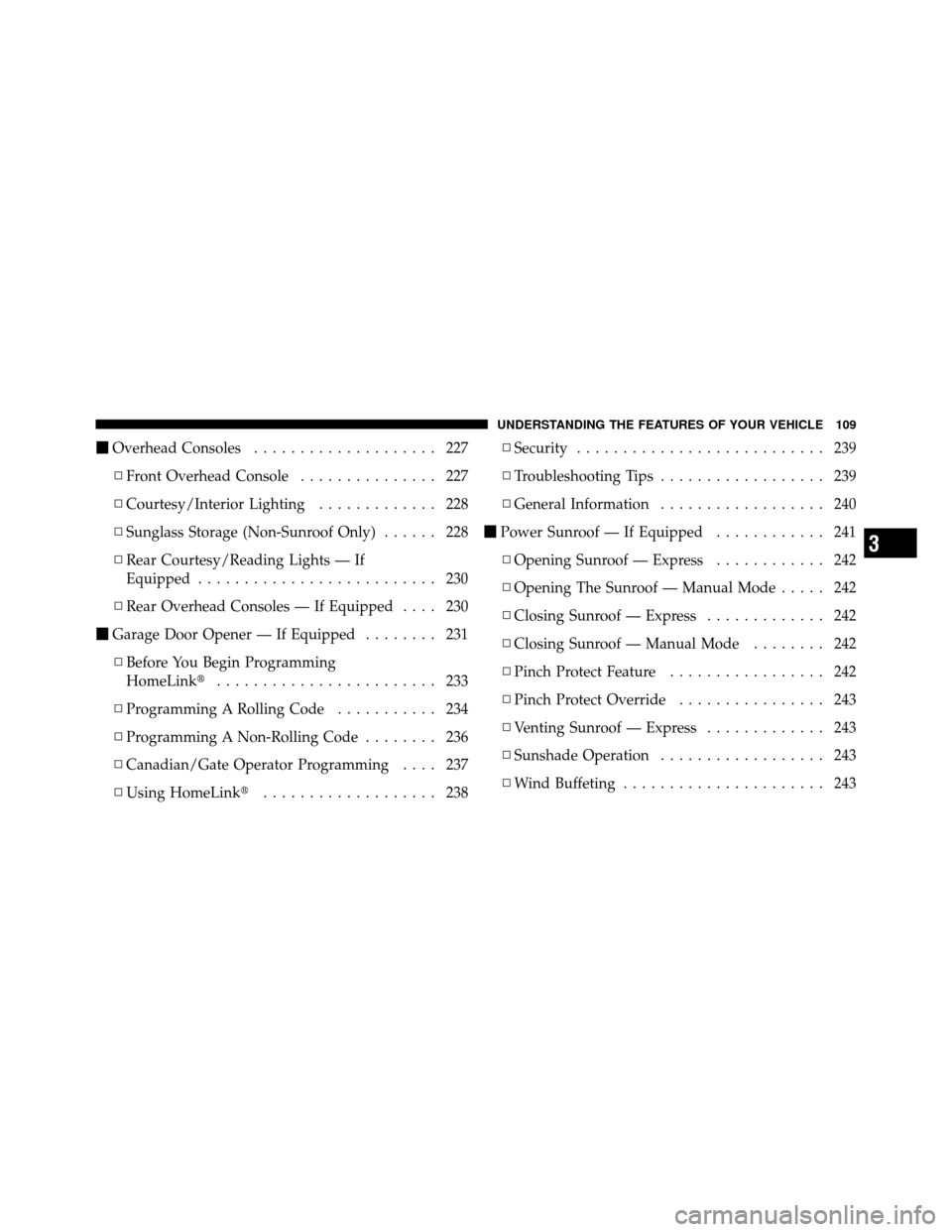Page 35 of 643

Cancel Remote Start
Remote Starting will also cancel if any of the following
occur:
•The engine stalls or engine speed exceeds 2500 rpm
•Any engine warning lights come on
•Low Fuel Light turns on
•The hood is opened
•The hazard switch is pressed
•The shift lever is moved out of PARK
•The engine is allowed to run for the entire 15-minute
cycle
To Turn Off The Engine While In Remote Start
Mode
Press and release the REMOTE START button one time or
allow the engine to run for the entire 15 minute cycle.NOTE:
To avoid unintentional shutdowns while in the
Remote Start Mode, the system will not allow the Remote
Start button to shut down the engine for two seconds
after receiving a valid Remote Start request.
When To Reset Remote Start
The vehicle can be started remotely up to a maximum of
two times. The vehicle is also allowed a maximum of one
failed start, where the Remote Starting sequence was
initiated but the engine stopped cranking without start-
ing. After either of these conditions, or if the Vehicle
Security Alarm system is alarming, or if the PANIC
button was pressed, the vehicle must be reset insert the
Key Fob into the ignition switch and turn the switch to
the ON/RUN position.
DOOR LOCKS
Manual Door Locks
Lock the front doors by pushing down on the lock knobs
on each door trim panel.
32 THINGS TO KNOW BEFORE STARTING YOUR VEHICLE
Page 47 of 643

•If anything obstructs the power sliding side door
while it is closing or opening, the door will automati-
cally reverse to the closed or open position, provided
it meets sufficient resistance.
•If the power sliding side door is not in the full open or
close position, it will fully open when a power sliding
door switch is pressed. To close the door, wait until it
is fully open and then press the switch again.
•If the power sliding door encounters multiple obstruc-
tions within the same cycle, the system will automati-
cally stop, the power sliding door motor will make a
clicking sound until the door has no further move-
ment. This clicking sound can be stopped by pulling
the inside or outside handle. If this condition occurs,
no damage is done to the power sliding door motor.
The power sliding door must be opened or closed
manually.
WARNING!
You, or others, could be injured if caught in the path
of the sliding door. Make sure the door path is clear
before closing the door.
Power Sliding Side Door Open Flash
The left and right exterior hazard lights will flash for
12 seconds when either sliding door is opened. This will
alert other drivers in the area that passenger(s) could be
entering or exiting the vehicle.
The Sliding Side Door Open Flash can be enabled or
disabled by performing the following procedure:
1. Place the Key Fob in the ignition switch.
2. Cycle the ignition switch from ON/RUN to OFF five
times ending in the ON/RUN position(do not start the
engine).
44 THINGS TO KNOW BEFORE STARTING YOUR VEHICLE
Page 53 of 643
The power liftgate may be closed by pressing the button,
located in the upper left trim in the liftgate opening.
Pushing once will only close the liftgate. This button
cannot be used to open the liftgate.When the RKE transmitter button is pressed and the
Flash Lights feature is enabled, the tail lights will flash
and several audible beeps will occur to signal that the
liftgate is opening or closing.
WARNING!
During power operation, personal injury or cargo
damage may occur. Ensure the liftgate travel path is
clear. Make sure the liftgate is closed and latched
before driving away.
NOTE:
•If anything obstructs the power liftgate while it is
closing or opening, the liftgate will automatically
reverse to the closed or open position, provided it
meets sufficient resistance.
Rear Power Liftgate Switch
50 THINGS TO KNOW BEFORE STARTING YOUR VEHICLE
Page 76 of 643

Advanced Front Air Bag Features
The Advanced Front Air Bag system has multistage
driver and front passenger air bags. This system provides
output appropriate to the severity and type of collision as
determined by the Occupant Restraint Controller (ORC),
which may receive information from the front impact
sensors.
The first stage inflator is triggered immediately during an
impact that requires air bag deployment. This low output
is used in less severe collisions. A higher energy output is
used for more severe collisions.WARNING!
•No objects should be placed over or near the air
bag on the instrument panel, because any such
objects could cause harm if the vehicle is in a
collision severe enough to cause the air bag to
inflate.
•Do not put anything on or around the air bag
covers or attempt to open them manually. You may
damage the air bags and you could be injured
because the air bags may no longer be functional.
The protective covers for the air bag cushions are
designed to open only when the air bags are
inflating.
•Do not drill, cut or tamper with the knee bolster in
any way.
•Do not mount any accessories to the knee bolster
such as alarm lights, stereos, citizen band radios,
etc.
2
THINGS TO KNOW BEFORE STARTING YOUR VEHICLE 73
Page 83 of 643

are not belted and seated properly, or if items are
positioned in the area where the side curtain air bag
inflates. This especially applies to children. The side
curtain air bag is only about 3-1/2 in (9 cm) thick when
it is inflated.
Because air bag sensors estimate deceleration over time,
vehicle speed and damage are not good indicators of
whether or not an air bag should have deployed.
NOTE:In a rollover the pretensioners and/or SAB and
SABIC air bags may deploy on both sides of the vehicle.
Front And Side Impact Sensors
In front and side impacts, impact sensors can aid the
ORC in determining appropriate response to impact
events.
Enhanced Accident Response System
In the event of an impact causing air bag deployment, if
the communication network remains intact, and the
power remains intact, depending on the nature of the
event the ORC will determine whether to have the
Enhanced Accident Response System perform the follow-
ing functions:
•Cut off fuel to the engine.
•Flash hazard lights as long as the battery has power or
until the ignition key is turned off.
•Turn on the interior lights, which remain on as long as
the battery has power or until the ignition key is
removed.
•Unlock the doors automatically.
In order to reset the Enhanced Accident Response System
functions after an event, the ignition switch must be
changed from IGN ON to IGN OFF.
80 THINGS TO KNOW BEFORE STARTING YOUR VEHICLE
Page 106 of 643

WARNING! (Continued)
•Always make sure that objects cannot fall into the
driver footwell while the vehicle is moving. Ob-
jects can become trapped under the brake pedal
and accelerator pedal causing a loss of vehicle
control.
•If required, mounting posts must be properly
installed, if not equipped from the factory.
Failure to properly follow floor mat installation or
mounting can cause interference with the brake
pedal and accelerator pedal operation causing loss
of control of the vehicle.
Periodic Safety Checks You Should Make Outside
The Vehicle
Tires
Examine tires for excessive tread wear and uneven wear
patterns. Check for stones, nails, glass, or other objectslodged in the tread or sidewall. Inspect the tread for cuts
and cracks. Inspect sidewalls for cuts, cracks and bulges.
Check the wheel nuts for tightness. Check the tires
(including spare) for proper cold inflation pressure.
Lights
Have someone observe the operation of exterior lights
while you work the controls. Check turn signal and high
beam indicator lights on the instrument panel.
Door Latches
Check for positive closing, latching, and locking.
Fluid Leaks
Check area under vehicle after overnight parking for fuel,
engine coolant, oil, or other fluid leaks. Also, if gasoline
fumes are detected or if fuel, power steering fluid, or
brake fluid leaks are suspected, the cause should be
located and corrected immediately.
2
THINGS TO KNOW BEFORE STARTING YOUR VEHICLE 103
Page 110 of 643

�Driver Memory Seat — If Equipped ........ 192
▫ Setting Memory Positions And Linking RKE
Transmitter To Memory ................ 192
▫ Easy Entry/Exit Seat (Available With
Memory Seat Only) ................... 195
� To Open And Close The Hood ............ 196
� Lights ............................. 198
▫ Headlight Switch .................... 198
▫ Automatic Headlights — If Equipped ...... 199
▫ Headlights On With Wipers — If Equipped . . 199
▫ Headlight Delay — If Equipped .......... 199
▫ Lights-On Reminder .................. 200
▫ Daytime Running Lights — If Equipped .... 200
▫ Front Fog Lights — If Equipped .......... 200▫
Dimmer Controls .................... 201
▫ Multifunction Lever .................. 203
▫ Turn Signals ........................ 203
▫ Lane Change Assist ................... 204
▫ High/Low Beam Switch ............... 204
▫ Flash-To-Pass ....................... 204
▫ Battery Protection .................... 204
� Windshield Wiper And Washers ........... 204
▫ Intermittent Wiper System .............. 205
▫ Windshield Wiper Operation ............ 206
▫ Windshield Washers .................. 206
▫ Mist Feature ........................ 206
▫ Rear Wiper And Washer ............... 206
3
UNDERSTANDING THE FEATURES OF YOUR VEHICLE 107
Page 112 of 643

�Overhead Consoles .................... 227
▫ Front Overhead Console ............... 227
▫ Courtesy/Interior Lighting ............. 228
▫ Sunglass Storage (Non-Sunroof Only) ...... 228
▫ Rear Courtesy/Reading Lights — If
Equipped .......................... 230
▫ Rear Overhead Consoles — If Equipped .... 230
� Garage Door Opener — If Equipped ........ 231
▫ Before You Begin Programming
HomeLink� ........................ 233
▫ Programming A Rolling Code ........... 234
▫ Programming A Non-Rolling Code ........ 236
▫ Canadian/Gate Operator Programming .... 237
▫ Using HomeLink� ................... 238 ▫
Security ........................... 239
▫ Troubleshooting Tips .................. 239
▫ General Information .................. 240
� Power Sunroof — If Equipped ............ 241
▫ Opening Sunroof — Express ............ 242
▫ Opening The Sunroof — Manual Mode ..... 242
▫ Closing Sunroof — Express ............. 242
▫ Closing Sunroof — Manual Mode ........ 242
▫ Pinch Protect Feature ................. 242
▫ Pinch Protect Override ................ 243
▫ Venting Sunroof — Express ............. 243
▫ Sunshade Operation .................. 243
▫ Wind Buffeting ...................... 243
3
UNDERSTANDING THE FEATURES OF YOUR VEHICLE 109